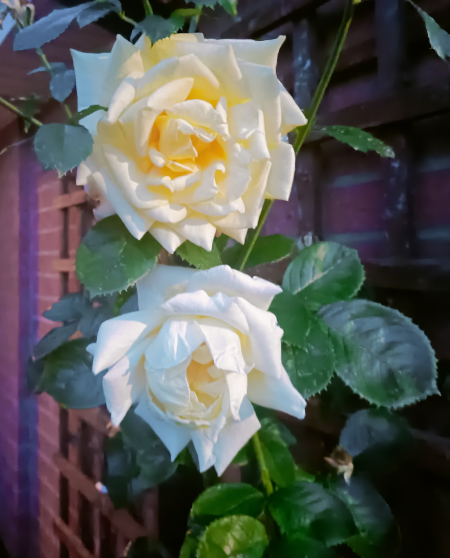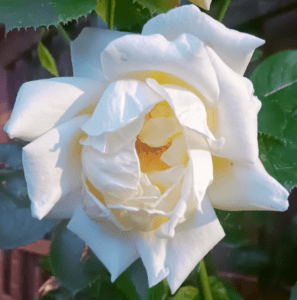Climbing roses are often vigorous growers, characterized by their long, arching canes that can be trained to ascend up trellises, pergolas, fences, or other structures. Roses are often dubbed as the ‘Queens of the Garden’ and the climbing variety can be seen from far away when other varieties can be obscured by other plants and shrubs.
Remember that claiming plants need a physical structure to climb. In our garden, a wooded trellis is used. The roses climb this by themselves, but sometimes some green gardening string is needed to keep them in check. Other times, new growth can be carefully threaded through the trellis.
At the end of each year, usually well after the growing season has finished and the flowers have all withered (and dead flower heads removed), we prune the climbing roses and in some cases cut back to just 1-2 feet to allow complete regrowth next season.
Pruning in the UK can be done from September to November, but in the USA, it may be better to leave pruning until late winter or early spring. There are different recommendations by different experts. See what suits your specific variety best by searching the internet for the name of the variety of climbing rose you have followed by the term ‘pruning’. We recommend not to cut back when frost may occur over the 4 to 6 weeks after pruning, otherwise, the frost may kill the rose.
Climbing roses possess a timeless allure that has beguiled horticulturists, poets, and lovers for millennia. Their pristine beauty, heady fragrance, and the sheer variety of colors and forms. This makes claiming roses one of the most popular and revered flowers in the world. In this article, we explore the captivating world of climbing roses and discover how to care for these bright, colorful and fragrant flowers that are loved the world over.
The Origin of Climbing Roses
The tale of the rose dates back millions of years, with fossil evidence suggesting their existence in prehistoric times. Native to the Northern Hemisphere, the wild species of roses have a vast geographical range, stretching from Alaska to Mexico and including northern Africa, Europe, and Asia.
Historical Significance
Historically, roses have left indelible imprints on various cultures. From Cleopatra’s rose-scented sails to the Wars of the Roses, these flowers have signified love, war, politics, and beauty. Over time, through natural selection and dedicated cultivation, thousands of rose varieties have been developed, each carrying its own distinct charm.
Physical Characteristics
The vast and varied world of roses can sometimes seem overwhelming to a novice gardener. Below is a breakdown of some key rose characteristics.
Height and Spread of Roses: While miniature roses may grow to a petite height of 6 inches, climbing roses can soar up to 20 feet or more. Most shrub roses, however, stand between 1 to 6 feet tall. The spread of a rose plant can range from 1 foot (30cm) for compact varieties to more than 5 feet (1.5m) for sprawling ones.
Foliage and Thorns: The leaves are typically pinnate with 3-7 leaflets, with some varieties boasting an enchanting array of thorns or ‘prickles.’
Colors of Climbing Roses: Roses are celebrated for their vivid spectrum of colors. Classic red roses symbolize love and desire, while white ones often denote purity. You’ll also find roses in hues of pink (gratitude), yellow (friendship), orange (fascination), and even lavender (enchantment). Moreover, roses come in a myriad of shades within these color groups, not to mention striped or tipped variations, providing gardeners with a palette to suit every mood and theme.
Rose Varieties
This article focussed on climbing roses. However, there are over 300 species of rose and thousands of cultivars. Popular varieties include Hybrid Teas, known for their classic flower form and long stems; Floribundas, which produce clusters of blooms; and Grandifloras, which are a blend of the previous two.

Roses, with their intricate diversity, can be classified into multiple types based on their growth habits, flower form, and other attributes. Among the broad categories, climbing roses, shrub roses, and bush roses stand out prominently. Now we delve into each of these types to understand their unique characteristics.
- Climbing Roses
Characteristics: Climbing roses are often vigorous growers, characterized by their long, arching canes that can be trained to ascend up trellises, pergolas, fences, or other structures. While they do not truly ‘climb’ like ivy or some other vines, their long canes can be affixed to structures, allowing them to achieve significant vertical height.
Flower Size and Color: Depending on the specific variety, the flowers of climbing roses can range from small to very large. They can produce both single and double blossoms, and their colors span the spectrum, including hues of red, pink, white, yellow, and even multi-color variations.
Noteworthy Point: Some climbers are repeats bloomers, flowering more than once in a growing season, while others might bloom just once, albeit profusely. - Shrub Roses
Characteristics: Shrub roses encompass a wide range of rose types which are bred to remain relatively close to the ground. They are typically hardy and disease-resistant, often with a more sprawling growth habit. This category includes English Roses, a famous type developed by David Austin, known for their fragrance and rosette-shaped blooms.
Flower Size and Color: Shrub roses can have a diverse range of flower sizes, from petite blossoms to those as large as five inches across. Their colors also vary widely, with many shrub rose varieties offering a mix of colors in a single bloom, producing a painterly effect. They can display shades of pink, red, white, peach, yellow, and more.
Noteworthy Point: Shrub roses are often prized for their ability to offer continuous blooms throughout the season. - Bush Roses (often referred to as Modern Bush Roses)
Characteristics: When gardeners refer to “bush” roses, they’re typically alluding to the modern, hybrid types that include Hybrid Teas, Floribundas, and Grandifloras. These roses tend to have an upright habit, making them suitable for formal beds and borders.
Flower Size and Color: Hybrid Teas often produce large, well-formed blooms typically on single stems, perfect for cut flowers. They are available in a vast range of colors, including some stunning bi-colors.
Floribundas: Smaller flowers than Hybrid Teas but bloom in clusters, offering a showy display. They too come in an array of colors.
Grandifloras: Combine attributes of the above two, producing both large flowers and clusters of blooms. They can be found in various hues. Noteworthy Point: Modern bush roses, especially Hybrid Teas, are renowned for their often strong and intoxicating fragrances.
In essence, the world of roses offers a delightful variety in terms of growth habits, flower forms, and colors. The choice between climbing roses, shrub, or bush varieties, often depends on your aesthetic preferences, available space, and desired maintenance level. Each type brings its own set of charms to the garden, ensuring that roses, in all their forms, remain timeless favorites among enthusiasts and casual admirers alike.

Care and Maintenance of Roses
Like any royalty, roses demand attention and care. Yet, with a few basic guidelines, even a beginner can nurture a garden blooming with resplendent roses.
Sunlight: Roses tend to thrive in direct sunlight. Ensure they receive at least 6-8 hours of sunlight each day.
Watering: While roses enjoy moisture, they despise waterlogged roots. Implement a deep watering technique, ensuring the water reaches the deeper root zones. Early morning is the best time to water them. This can help to prevent the onset of fungal diseases.
Soil: Well-draining soil rich in organic matter is ideal. A pH level of 6.5 (very slightly acidic) is optimal. If your soil is clayey, amend it with compost or organic matter to improve drainage.
Pruning: An essential aspect of rose care, pruning enhances the plant’s shape, removes dead or diseased wood, and encourages blooming. The best time to prune is late winter or early spring when the buds begin to swell. Start by removing dead, diseased, or thin branches. Make cuts about 0.25 inch above a bud that faces the outside of the plant to encourage outward growth.
Deadheading: This refers to the removal of faded blooms, preventing the plant from setting seed and encouraging more flowers. Cut the stem down to the first set of 5-leafed foliage or to the desired length.
Disease and Pest Management: Regularly inspect your roses for signs of pests like aphids or diseases such as black spot. While maintaining cleanliness and ensuring good airflow can prevent many issues, sometimes organic or chemical treatments might be necessary.
In summary, the rose, with its myriad of forms and colors, offers gardeners a unique opportunity to paint their gardens with living art. Their rich history and the depth of emotions they evoke make them stand out in the botanical world. With appropriate care, attention to their needs, and timely maintenance, roses can flourish and elevate the aesthetics of any garden.
In the words of Anne Bronte, from West Yorkshire, UK, ‘But he who dares not grasp the thorn, should never crave the rose’. Embrace the journey of growing roses, and the rewards will be bountiful! If you get a chance to visit the Bronte Parsonage whilst on vacation, do.
Thank you for reading this article about climbing roses. We hope that you have found it an enjoyable, insightful, and informative read. Please bookmark AboutPlants.com if you would like to revisit the site as a reference for other types of plants, trees and shrubs. If you have any comments or have noticed any issues or inaccuracies, please get in touch.